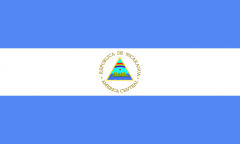
Nicaragua, officially the Republic of Nicaragua, is the largest country in the Central American isthmus, bordering Honduras to the north and Costa Rica to the south. The country is situated between 11 and 14 degrees north of the Equator in the Northern Hemisphere, which places it entirely within the tropics. The Pacific Ocean lies to the west, and the Caribbean Sea to the east. The country's physical geography divides it into three major zones: Pacific lowlands; wet, cooler central highlands; and the Caribbean lowlands. On the Pacific side of the country are the two largest fresh water lakes in Central America—Lake Managua and Lake Nicaragua. Surrounding these lakes and extending to their northwest along the rift valley of the Gulf of Fonseca are fertile lowland plains, with soil highly enriched by ash from nearby volcanoes of the central highlands. Nicaragua's abundance of biologically significant and unique ecosystems contribute to Mesoamerica's designation as a biodiversity hotspot. Wikipedia
Nicaragua is in many ways like a more affordable and less developed version of Costa Rica. Hard Trekkers will find these differences incredibly appealing. Popular activities include visiting beautiful pacific ocean beach towns, climbing island volcanoes, and ash-skiing volcanic slopes. There is a lot to do in Nicaragua, and nearly all of it can fit a pretty meager budget. It's no accident this is a popular stop in the not-uncommon Central American backpacker trail.
Almost all travel within Nicaragua is by bus. Everything is relatively close, and grabbing whatever bus is leaving next to wherever you are headed is generally convenient and inexpensive. Just make sure you're not paying triple what the locals pay!


